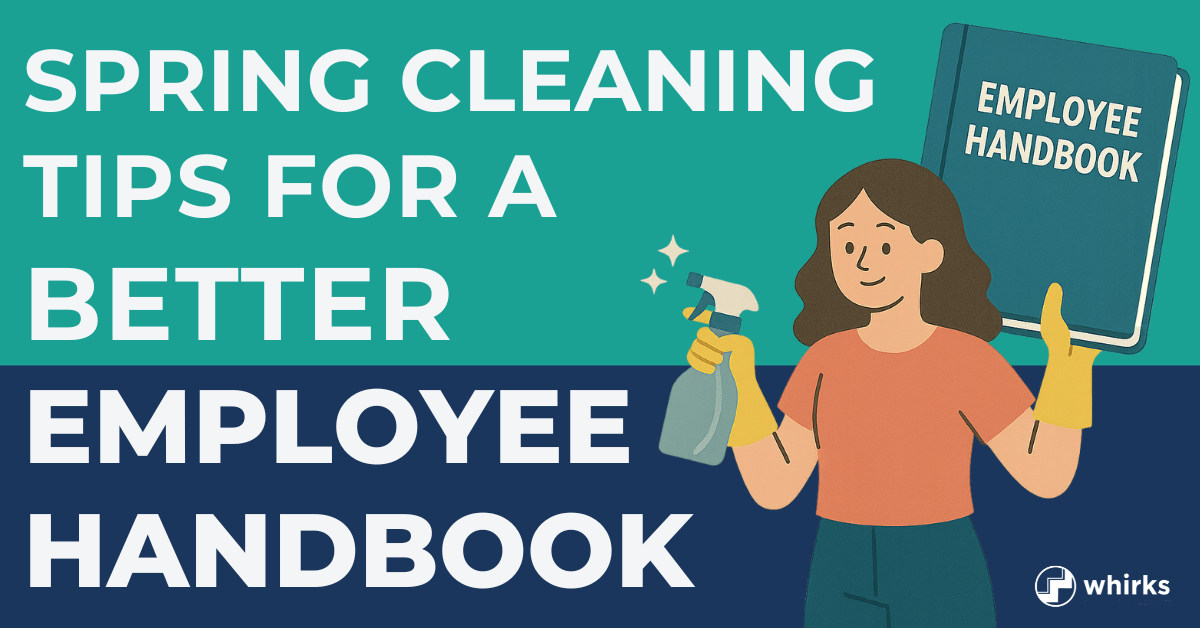
There’s just something about that spring-time energy. We’ve got an extra hour of daylight now and the air is warming up. Doesn’t it just make you want to review your company handbook and workplace policies? No?
As boring as it seems, it’s important to make sure your handbook and company policies are up to date with not just legal matters but your company culture. It’s not really the big task you might think it is! Let’s break it down together:
Step One: Dust Off Your Employee Handbook
The first step in your handbook refresh is to dust off outdated language and ensure compliance with current regulations. Laws surrounding wages, paid leave, workplace safety, and remote work requirements often change, and if your policies don’t reflect those updates, your company could be at risk.
Review federal, state, and local regulations to know that your handbook remains legally sound. For example, if your state has recently implemented or expanded paid family leave programs, your handbook should clearly outline employees' rights and benefits.
Beyond compliance, you want your handbook to reflect your company’s current policies and culture. If your organization has shifted to a hybrid or remote work model, added new DEI initiatives, or updated benefits, these changes should be documented. This is also a great chance to simplify overly formal or confusing language so employees actually understand what's expected. Rewriting policies in plain, clear terms helps prevent misunderstandings down the road.
Step Two: Scrub Outdated olicies and Shine U New Ones
Just as forgotten clutter can accumulate over time, so can outdated or redundant policies in your handbook. Take this opportunity to review and remove policies that no longer reflect your company’s operations or best practices. For instance, if your performance review process has evolved from annual reviews to a continuous feedback model, ensure your handbook reflects this change. Likewise, if disciplinary actions or corrective measures have been revised, update your policies to provide clear and fair guidelines.
While scrubbing away outdated policies is essential, spring cleaning isn’t just about removing the old... it's about making space for the new.
Workplace trends are constantly evolving, and your handbook should keep up. Consider adding policies on emerging issues such as artificial intelligence (AI) usage in the workplace.
Many employees are incorporating AI tools like ChatGPT into their workflows, but without clear guidelines, there may be confusion about what’s permitted. Similarly, cybersecurity policies (sometimes called a “Written Information Security Plan", or WISP) should address increasing threats, emphasizing data privacy, password security, and multi-factor authentication.
Updating your handbook with these kinds of relevant, forward-looking policies helps your organization stay current and better prepared for the future.
Step Three: Organize and Communicate Updates
Once your handbook is cleaned up, the next step is sharing those updates with your team.
If you have a lot of changes taking place, you may want to host a lunch-and-learn to walk employees through key updates, highlighting any major policy changes and how they impact daily operations. If there are just a few updates, consider recording a quick video to help employees quickly understand how those changes affect them.
After reviewing updates, you should obtain written acknowledgment from employees, confirming they have read and understood the revised policies. Digital acknowledgment forms or electronic tracking through your HR system can streamline this process and provide a record for compliance purposes.
To maintain an up-to-date handbook moving forward, establish a regular review process—whether quarterly, biannually, or annually—so your policies stay relevant and aligned with industry trends and legal requirements.
Fresh Start for a Stronger Workplace
If this felt like a big task for you this year, consider some ways to alleviate that for yourself next year. I would suggest you have your own copy of the handbook on your computer (or even print it out if you’re a paper person) and make notes throughout the year about changes that need to be made. For example, if you have employees constantly asking for clarity on the PTO policy, you may want to make a note to revise the wording to be more clear. This way, when you go to do a refresh you can recall those items more easily.
From Dusty to Trusty — Turn Your Handbook into a Real Asset
Spring cleaning isn’t just for your home. It’s a valuable practice for keeping your workplace policies fresh, clear, and compliant. By dusting off outdated policies, scrubbing away unnecessary clutter, and shining up new ones, your employee handbook can remain a useful and legally sound resource for your organization.
Regular updates mean employees understand expectations, feel supported, and have access to the latest workplace guidelines. Take advantage of this season of renewal to refresh your handbook and set your workplace up for success!
Now that you’ve got a handle on refreshing your handbook, take it a step further by avoiding the most common missteps. Check out 5 Mistakes to Avoid in Your Employee Handbook to make sure you’re not overlooking something that could cause confusion (or even legal trouble) down the line.
Topics: